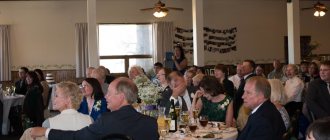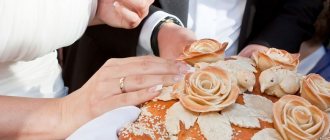The role of rituals
Each culture has its own individual holidays, but in almost all of them a wedding is celebrated. Marriage traditions began to emerge in every nation even when it was just being formed, so countless variations have survived to this day. Find out more about Russian traditions.
Such customs form the invisible framework of the wedding scenario. Even if the bride and groom do not realize it, many of their actions are also a kind of tradition. A white wedding dress, a ransom, a wedding procession, an exchange of rings, a kiss that seals the marriage - all this has passed through the centuries, only minor details change.
Following traditions does not mean that the wedding will be the same as everyone else's. Now there is a tendency to either hold a wedding in a Western style, or completely abandon any customs in favor of a calm celebration in the family circle. Those couples who observe the long-standing traditions of their people at their wedding always look more original and natural.
Interesting!
How the newlyweds are met by their parents at the entrance to the cafe
Immediately after the painting, at the exit from the registry office, guests meet the newlyweds lining up in a long corridor. When the newlyweds walk, they throw candy, rice, rose petals, and coins at them. After this, everyone present goes to where the wedding will take place - in a cafe or at home, where their parents are already waiting for them. How does the meeting of the bride and groom take place?
As soon as the newlyweds approach their parents, no one should stand behind them. It will be impressive if the spouses’ friends line up in a tunnel with a rose in their hand, through which the heroes of the occasion will pass. The groom can carry his beloved in his arms, accompanied by shouts of “Congratulations” from those present.
As a rule, they must come up and bow to the father-in-law and mother-in-law from the waist. Parents meet the newlyweds at the entrance to the banquet hall. The groom’s mother stands with a loaf of bread and salt, and his father stands with an icon and a basket of change, wheat and sweets. When the heroes of the occasion approach the parents, they will shower them with the contents of the basket for a rich, happy, joyful life. As for the bride's parents, mom holds a plate with honey and a teaspoon, and dad holds glasses of wine or champagne. What icon can you use to greet children? An icon of the Mother of God, the Wonderworker, or the face of another saint would be suitable. These actions mean that the mother-in-law gives her blessing to the children for a happy life in abundance, and the groom’s father with the icon reminds of the sacredness of love, so that they take care of their family. It would be appropriate if the loaf was on a beautiful embroidered towel, and on it or next to it there would be a salt shaker. The newlyweds cross themselves, then break off a piece of the loaf. The one who breaks off the largest piece will make important decisions in the young family.
Next, they salt a piece and treat it to each other, agreeing not to salt each other again. It is advisable to eat these pieces, and given that the bride and groom will most likely be hungry, this will not be difficult. It is worth noting that today newlyweds order these holiday pastries not with salt, but with sugar or chocolate, so that their life will be sweet. Blessed by the groom's parents, the newlyweds listen to congratulations from the young wife's mother, who gives them a taste of honey and wishes them a sweet life and an endless honeymoon. After the bread is eaten and the honey is tasted, the bride and groom take glasses of wine from the bride's father and empty them completely. Some spouses break glasses when I drink from them to make life happy. Some people drink from these glasses throughout the wedding celebration, and break them at the end of the holiday. Others keep glasses as souvenirs. Here it’s as anyone wants. If you decide to break the glasses, then you should pay attention to the fragments. There is a sign that small fragments signify the birth of a daughter, and large fragments signify the birth of a son. Next, the spouses kiss their parents three times on the cheeks as a sign of gratitude. After this, the newlyweds, parents and guests go to the banquet hall to celebrate. If the wedding celebration is held at the groom's home, then the parents meet the newlyweds on the threshold of the apartment. After this, everyone present goes to the banquet hall or the place where they will celebrate the holiday.
The role of baking at the holiday
Nowadays it is customary to treat wedding guests to a large and richly decorated cake, but in the past homemade cakes of all shapes and sizes were popular. The newlyweds themselves were also treated to a culinary masterpiece from the oven - a round, large loaf of bread, shining in the light, with patterns in the form of an ethnic ornament. Each element of such a design was carefully thought out and had a symbolic meaning:
- braids and weaving - sealing the destinies of the newlyweds and their future children into one common one;
- viburnum and roses - a wish for mutual love and respect;
- two swans - a symbol of the newlyweds themselves, who swore eternal fidelity to each other;
- grapes are a symbol of fertility, a wish for quick, strong and healthy offspring.
The loaf itself is unsweetened white bread, most often round in shape, since it symbolizes the sun. This wedding pastry represents the unity of two hearts, as well as fertility, prosperity and prosperity . It was with the loaf that the wedding feast began, and the salt served with it symbolized a comfortable life.
The wedding celebration begins with the meeting of the newlyweds with a loaf and the words of the parents. The newlyweds, after the official wedding ceremony, must break off or bite off a piece of this traditional wedding pastry. It is believed that the one who has more will be the head of the family. You can do with the rest of the loaf at your discretion: give it to guests, take it home with you to eat whole or dry.
In another variation of this tradition, the bride and groom break off a piece of baked goods, sprinkle it with salt and feed it to each other. It is believed that at this moment they can “annoy” each other for the last time, and after that they should live in harmony and peace. After this, the salt can be poured into a fabric bag to keep as a keepsake.
How is it customary today to greet young people after the registry office?
Upon completion of marriage registration or after the wedding, already being husband and wife, the young couple meets their loved ones for the first time in the status of spouses. This meeting marks the acceptance of the groom's daughter-in-law into the family and includes three stages. The first stage is a rain of grains and petals. The second is a wedding loaf with salt. The third is breaking glasses for good luck.
Initially, the invited guests line up in two lines towards the threshold of the house (now most often it is a restaurant), where the parents stand. With words of wishes and congratulations, the guests arrange an unusual “rain” for the newlyweds. By the way, real rain on a wedding day is a very good omen, foreshadowing happiness and prosperity for the newlyweds. Guests shower the newly-made husband and wife with various grains (rice, buckwheat, millet) so that there are as many children in their house as there are grains in an ear of grain; money - for family security; candies - for the sweet life, rose petals and confetti - so that the newlyweds' life together is romantic and magical. “Rain” must be arranged carefully, otherwise there is a risk that young people and guests will take a long time to shake the grain out of their outfits and hairstyles.
Features of the tradition
The wedding loaf was always baked in the groom's family, and this particular task went to a married relative who was happily married and had several healthy children. If the mother matched the description, then she took upon herself the responsibility of making a wedding masterpiece. Widows, single or childless relatives were not allowed to participate in this important stage, since it was believed that they could pass on some of their troubles to the newlyweds. While kneading the dough, the woman sang cheerful songs about love, happiness and peace, and when the bread went into the oven, she read prayers over it.
Sometimes the groom's male relatives also got to take part in making the loaf. When the dough was ready, a happily married man with numerous and strong offspring sent it to the oven, and then the woman came to the fore again.
Who holds the loaf when the newlyweds meet? The ceremony of meeting the newlyweds with a loaf of bread after the wedding was organized by the groom’s parents. His mother held a loaf of bread in her hands on a rushnik (towel) specially embroidered for this day. Most often, the decoration of this accessory was entrusted to the bride during preparations for the wedding, and the pattern could be made in any way. Doves were often depicted as a symbol of love, or roosters as the personification of the beginning of a new life for the newlyweds.
Previously, the meeting of the newlyweds with a loaf of bread after the wedding took place on the threshold of the house of the groom's parents, since it was there that the married couple was to settle. This is also due to the fact that the making of baked goods was entrusted to the family by the newlywed. Nowadays, newlyweds in most cases, after the official wedding, go to a banquet, and do not live with their parents at all, so the parents of the newlyweds meet them with a loaf, as a rule, at the entrance to a cafe or restaurant.
Guests also take part in this tradition: they form a kind of living corridor, standing on both sides of the road to the doors of the establishment, and shower the newlyweds with millet, oats, rice, coins, sweets or flower petals. This is how friends and relatives wish the newly-made spouses happiness and prosperity in the family.
The words of the mother-in-law when meeting the newlyweds with a loaf of bread must be prepared in advance, since the congratulatory speech must be coherent and come from the heart. It is not forbidden to read the text as written, but it will look more impressive if it is memorized.
Other parents also have their roles in this tradition. The mother of the bride holds two glasses of champagne or a soft drink in her hands. After the newlyweds try the loaf, they empty their glasses and break them, throwing them over their left shoulder for good luck. The mother-in-law can also accompany this process with words of congratulations. The words of the bride's mother for meeting the newlyweds with a loaf can also be prepared in advance. The groom's father usually holds an apple on a tray so that the newlyweds can snack on champagne, and the bride's father holds an icon for blessing.
Preparing for the meeting of the newlyweds
In the Slavic tradition, after the official painting, the newlyweds are greeted by their parents with a loaf of bread or bread and salt. The loaf is a symbol of hospitality and abundance in a large family, the house of which includes a new member - the daughter-in-law.
People still perform this beautiful and cheerful ritual today. All participants have their own role, say important words, perform rituals that can be adapted to their conditions; we will consider a universal version of such a ritual below.
Traditional wedding loaf
According to tradition, a wedding loaf should be large, round, with various decorations. Each of the decorations on the wedding loaf symbolizes its own special meaning.
So, for example, swans are considered a symbol of fidelity and devotion, roses and viburnum symbolize love, ears of wheat are identified with prosperity and wealth, intertwined braids are the intertwining of the destinies of the bride and groom, grapes are identical to fertility in business and the desire for offspring.
A lot of symbols are used on loaves, but everyone determines for themselves which ones should be on their loaf and, accordingly, on the path of life.
When preparing for a wedding, most often the wedding loaf is ordered from a store and is very rarely baked with one’s own hands. But it’s better to bake wedding bread with your own hands, with your soul.
Now preference is given to luxury in outfits and decorations, and the loaf is served stamped.
But it’s better to find an opportunity and make it for the groom’s parents with their own hands, or find a person with a kind soul among your friends and ask him to bake a loaf.
Since ancient times, a loaf of bread was baked by a woman who was happy in her marriage, kneading the dough and singing songs about love and happiness in the family, then forming the loaf in the shape of a circle, which symbolizes the sun, and singing prayer songs. The loaf should be put into the oven by a man who is happily married.
Wedding towel
An integral element for meeting newlyweds with a loaf is an embroidered towel.
According to the Slavic tradition, a wedding towel for a special ceremony (called “bread and salt”) should be embroidered by the best craftsmen, since the towel must be beautiful and at the same time carry certain semantic information. The symbols of the loaf and the embroidered towel are similar.
Such a towel should be embroidered on both sides, one side for the husband, the other for the wife, arranged in 3 rows:
- the first row symbolizes the heredity of kinship;
- the second row of symbols is responsible for wishes and blessings for the young;
- the third row is a talisman for the future family, because the crown is a symbol of God's blessing.
Everyone chooses for themselves whether to honor the traditions of their ancestors or to neglect them. However, if they have come to us through a long tape of centuries, then it’s probably worth sticking to them and not forgetting.
Toastmaster's speech
If the toastmaster will be present at the wedding, then he needs to accompany with comments every stage of the celebration, including the meeting of the newlyweds at the door of a cafe or restaurant.
A professional toastmaster knows how to greet young people with a loaf of bread and what to say. After the registry office, the bride and groom usually go to a photo shoot, and guests wait for them at the banquet hall. The presenter makes sure that everyone stands in their place and knows what to do and say when the young people meet with the loaf. The words of the toastmaster during the performance of this tradition may be the following:
“Dear newlyweds (names of the bride and groom)! At this solemn hour, you are greeted by the people dearest to you - your parents. The groom’s mother has a delicious loaf of bread on her lovingly embroidered towel, baked as a symbol of love and prosperity, with the warmest feelings.
Newlyweds! Looking into each other's eyes, break off a piece of this wedding bread, salt it well and feed each other. You have a unique opportunity to annoy each other for the last time, and to the cheers of friends and relatives. And whoever gets the bigger piece will be the head and breadwinner of the family! Well done, groom (or bride), so you will have a difficult burden.”
Scenario for the meeting of the bride and groom with a loaf
According to modern traditions, while the newlyweds are getting from the registry office to the place of the wedding banquet (as a rule, this time is devoted to a wedding photo shoot), parents and guests go to the restaurant. They must make important preparations to meet the newlyweds with the loaf. All participants in the wedding celebration (the newlyweds, their parents, guests) take part in the ritual with bread and salt:
- Guests should solemnly welcome the newlyweds to the music, generously strewing their path from the car to the restaurant with coins and rose petals.
- Moms and dads sacredly bless their children at the doorstep for a long, happy family life.
- After the parents pronounce certain words, the newlyweds must tear off a piece of loaf (during this they salt it or dip it in salt, which is poured in the center of the bread) to feed each other.
- It is important for newlyweds to observe the moment of breaking off the loaf one piece at a time. This is a holy object, biting which would be gross blasphemy and sin.
- At the end of the ceremony, the newlyweds take a sip of champagne and then pour the rest behind their backs to complete the ritual.
It is believed that the young one who breaks off the largest piece of bread and salt will be the head of the family. This seemingly simple ancient ritual requires careful preliminary preparations in a short period of time while the heroes of the occasion get to the place of the wedding banquet. In order not to fall on your face, it is important to find out in advance what each character in the script needs to do and what words to say. We'll look at this in more detail below.
Preparing guests for the newlyweds' meeting
Having reached the restaurant, everyone gathers on the threshold in anticipation of the main heroes of the occasion. Guests must first be prepared by placing in their hands items for showering the newlyweds: various coins, sweets, rice or wheat, rose petals. Next, all the invitees are lined up in an orderly manner on both sides at the entrance to the establishment (living corridor) for the ceremonial meeting of the bride and groom.
It is important that the ritual of showering the newlyweds does not take place too intensely, so as not to injure the newly born couple with coins or spoil their appearance. It is necessary to explain to the guests that they should sprinkle the newlyweds at their feet, as if paving the young people’s life path with wealth, prosperity, and happiness. All organizational aspects of this tradition must be carried out by the toastmaster.
Who holds the loaf and how?
After the guests shower the newly arrived newlyweds along the lively corridor, the latter step on the threshold of the restaurant. Here they are already warmly welcomed by their parents along with bread and salt. According to established traditions, the groom’s mother holds the loaf, but not with her bare hands, but on a beautifully embroidered towel. However, modern weddings depart a little from old customs, and the bride’s mother can hold the loaf.
This is due to the fact that today's newlyweds do not go to live with the groom's parents (as was the case in the old days), but begin their independent family life in separate housing. And if so, it means that both families (parents of the bride and groom) accept new members into their composition on equal terms. Both mothers can hold the loaf, personifying the reunion and unity of two families.
The role of fathers in the ritual of meeting young people
While mothers hold the main attribute of the solemn meeting of the newlyweds (loaf), fathers do not stand idle. In the hands of one of them there should be a tray with a drink, with which the newlyweds seal their union, according to custom, and snack on a cut apple in half. And the other dad holds an icon, with which parents all together bless their children for a long, happy family life.
The ritual of treating guests to a wedding loaf
After the end of the ceremony of welcoming the bride and groom with bread and salt, the newlyweds and their guests go into the hall and dance their first dance. Then the ritual of treating the invitees to a wedding loaf takes place. Under no circumstances should this attribute be sold, like a wedding cake. From time immemorial, bread was considered a holy symbol, which must be fed without selfishness, with a pure soul and heart. Therefore, the newlyweds go around the banquet table, treating each invited guest to a generous piece of loaf.
During the meal, guests should make a speech of gratitude and sincerely congratulate the bride and groom on the birth of their family. In the modern version of a wedding celebration, the newlyweds, as a rule, remain in their places, and the toastmaster with a tray and chest goes around all the guests. The tray is for distributing a delicious loaf, and the chest is for collecting gifts presented by people gathered for this occasion.
Parents' speech
The words when the newlyweds meet with a loaf of bread mainly consist of congratulations and parting words. The mother-in-law can give her short speech in prose or poetry. It is desirable that the text comes from the heart, without pretense.
For example, congratulating the newlyweds during a meeting with a loaf of bread may look like this:
“Our dear children! We sincerely congratulate you on the starting point in your new life, on the birth of your family. I bless you for a long and happy married life, may there always be peace and order in your home!”
There is another option for the text of congratulations:
“Dear children! We are immensely glad that in this huge world your hearts found each other and merged together, and today we are all witnessing the triumph of your warm feelings for each other. Previously, I only had a son, but now I also have a wonderful daughter. I wish that harmony and mutual understanding reign in your home, so that the ringing laughter of children does not cease within the walls of your family nest. Love each other and be happy!”
You can link your congratulations directly to the loaf itself:
“Dear children! We bless you on your journey together and wish that the warmth in your hearts, like in this loaf, does not fade away, but warms you and everyone around you. May your home be full of joy, love and welcome guests. Happy holiday, my dears!”
How to meet newlyweds after the registry office: some deviations from traditions
It is not always possible to fully perform these rituals. In such cases, a young family can receive blessings in another way.
Immediately upon leaving the registry office building, the newlyweds may be greeted with a loaf of bread or simply with champagne and sprinkled with various symbolic objects. Also at this moment, many couples like to release doves.
Also, due to life circumstances, a husband’s parents cannot always bless him with a young wife. Then the oldest relative in the family takes on this function. In addition, the groom’s godparents can also give a blessing to the young family.
In addition, not everyone knows how to welcome newlyweds after the registry office at home, if this is not the case. And this is not surprising, because there can be a variety of rituals here. One of the traditions, for example, is seeing a young couple home, where, before entering the apartment or the house itself, the groom must carry his bride in his arms through a lock lying on the floor. After which, the eldest in the family closes this lock and throws away the key. This symbolizes the end of a man’s single life.
Following these customs, unfortunately, does not protect against problems in family life. However, creating a festive atmosphere at a wedding is impossible without them. And sincere wishes of love and happiness make this day even more special for the newlyweds.
Finally you are husband and wife! You answered each other “Yes!” in the face of the law and solemnly placed the rings on their ring fingers. It's time to leave the registry office to continue the wonderful, eventful, solemn wedding day. But you also need to be able to leave the registry office.
Leaving the registry office is a historical moment in the life of a young family. These are the origins - the very first minutes of the existence of a new married couple.
Who does the baking
If desired, the groom's family can follow the old tradition and make their own wedding cakes. Of course, this process has not been accompanied by songs and prayers for a long time, but it is better to observe the condition for a happily married woman. Many people believe that baking transmits positive energy from the person who cooks it .
Now there are options that are much simpler - anyone can order a loaf of bread in a bakery or in a special store for a relatively low price. At the same time, you can be sure that the baked goods will turn out tasty and beautiful. You can make any decorations on the loaf, it all depends on the wishes of the customer. In order not to purchase an additional salt shaker, you can order a loaf with a special recess in the middle where salt is poured. You need to order the loaf in advance so that the baker can bake it on the day of the holiday. In this case, it will be fresh, soft and aromatic.
Interesting! Find out how to make, decorate and use a towel for a loaf of bread at the holiday.
Additional Tips
Each stage of pre-wedding preparation has certain nuances that need to be taken into account so that everyone is satisfied. Regarding the tradition of welcoming newlyweds with a wedding loaf, the following advice is given.
- Parents are not always present at weddings in full force. If necessary, the mother-in-law can be replaced by any relative on the groom's side or by any person close to the newlyweds.
- The loaf does not replace the wedding cake, despite the fact that this pastry was previously used for the dessert part of the banquet.
What to say when young people meet with a loaf of bread? When serving a loaf of bread, it is not so important what exactly the mother-in-law says, but what matters is how she does it. Even simple words can warm the soul if they are spoken with warm feelings and intentions. You can choose a ready-made version or write the text yourself, the main thing is that it pleases the newlyweds.
admin 115
Previous article
Elegant lilac wedding cake – photos of desserts with white tones in the decor
Next article
How to meet newlyweds after the registry office: the scenario of a Christian ritual
If the newlyweds and their parents adhere to Christian traditions and want the ceremony to take place exactly according to the rules, it is best to first consult with the priest of the church that the newlyweds attended. He will tell you how to greet the groom's young parents after the registry office, what icons should be in their hands and what words are best for them to say.
The blessing itself is carried out immediately before the room in which the wedding feast will take place. Guests and parents of the newlyweds arrive in advance. A young husband and wife, as a rule, go for a walk or a walk after the registry office. And if they immediately head to the banquet place, they should not rush so that all the invitees have time to get ready.










